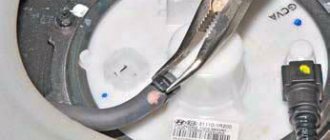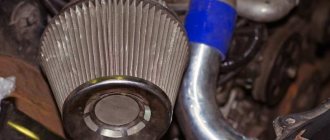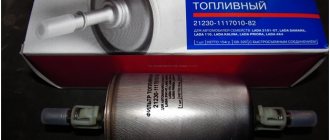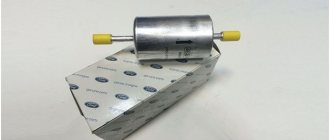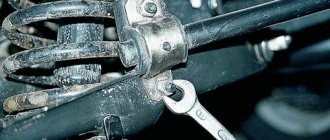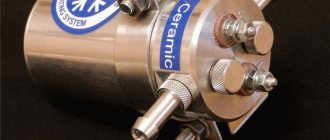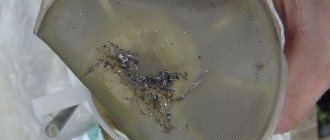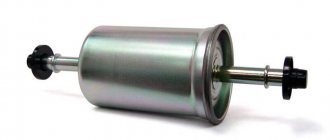The main task of a fuel filter device is to clean the fuel from unnecessary particles that have entered it. The presence of water in the fuel system causes rusting of the injectors, leads to the development of corrosion, and this leads to engine dysfunction and clogs the fuel system. This element of the car helps clean low-quality fuel from particles of resins and all kinds of additives that are added to fuel by unscrupulous manufacturers.
The fuel filter can become dirty as a result of:
- accumulation of dust and dirt due to a possible chemical combination of gasoline with air and metal;
- corrosion caused by water condensation;
- accumulation of tarry sediment;
- clogging of fuel equipment pipes with frozen water crystals at low temperatures.
- using low quality fuel.
Purpose
Condition of the new and old filter elements (new on the left).
The main task of a fuel filtration device is to clean fuel from harmful impurities: particles of dust, dirt, insects, plants, resins, and condensate. The presence of water in the fuel system leads to rusting of the injectors and contributes to the development of corrosion, which is very detrimental to the normal operation of the engine; these harmful impurities can clog the fuel system. This device allows you to clean low-quality fuel from particles of resins and various additives added to fuel by unscrupulous manufacturers.
Depending on the technological features and type of injection, various fuel filters are distinguished:
- For carburetor cars, it is necessary to clean the fuel from dirt particles up to 20 microns.
- On machines equipped with an injector, the degree of cleaning is up to 5 microns. Particles smaller than the specified size will penetrate the injection system, but cannot cause significant harm.
- Diesel power units use special fuel filter elements that can not only remove dirt particles smaller than 4 microns, but also prevent small drops of water from entering the injection system.
We recommend watching a video demonstrating the symptoms of a clogged fuel filter:
Types of filter elements
Depending on what fuel the vehicle is oriented towards, a specific filter device is installed in it. Let's talk about them in a little more detail.
Carburetor filter
Since a carburetor engine has low pressure, the working mixture enters the engine through special rubber hoses. It is into them that the filter element “crashes”. This can be a product made of plastic or metal. The product has 2 tubes (inlet/outlet). For maximum reliability, the hoses are secured using special clamps.
Injector filter
The peculiarity of this element is the transfer of key functions to the central electronic unit. The working mixture enters the engine under high pressure, and this requires the presence of metal fuel lines of the highest quality. If we talk about the fuel pump itself, it is made of steel or other particularly durable metals. Threaded elements are used as connectors.
Diesel filter
Diesel engine fuel is considered the “dirtiest” of those existing today; it requires increased purification from all kinds of impurities. Paraffins pose the greatest danger to the internal elements of a car. They, transforming into crystals, clog the main gaps in the parts. Therefore, vehicles running on diesel fuel are usually equipped with two filtering devices – the main one and the additional one. This allows you to clean the fuel from unnecessary impurities by 100%.
Types of filters
In addition, filter elements installed on vehicles differ in the following characteristics:
- degree of cleaning (coarse/fine);
- type of casing (metal/plastic);
- working pressure (high/low);
- type of fuel (diesel/gasoline).
Differences in engines
Fuel filter problems do not arise out of the blue. Which symptoms appear first depends on the type of power unit.
- Diesel: the engine does not start the first time, the movement is jerky.
- Injector: the power of the traction device is reduced.
- Carburetor: clogging occurs gradually and with virtually no changes in control.
Although the first signs do not seem so important, they cannot be ignored. You should listen to any changes in the operation of the engine and replace the filters in a timely manner.
If your car has a diesel engine, and you have enough experience and skills in handling the car, then you can replace the fuel filter yourself. If the car has an injection or carburetor system, then it is advisable to immediately contact a service center.
Operating principle of the vehicle: general view
Fuel liquid is supplied to the injectors under high pressure. The pump solves this problem. As for adjusting the pressure, because it must be the same for each of the cylinders, a special regulator is responsible for this - the RTD. In injection systems, the amount of injected gasoline or diesel fuel must also be regulated. It, in turn, is formed according to the duration of the impulse.
The pressure in the injection system is the most important parameter. Its indicator, as a rule, varies between 2.8-3.2 atm. At this pressure, no aberrations in the functioning of the motor should be observed.
Replacement frequency
There are certain service periods prescribed by manufacturers. But in fact, taking into account the quality of the fuel and the condition of the roads, it is advisable to look at the mileage and the condition of the engine. This means only one thing: no one will give you specific dates. Hence the conclusion: if the fuel filter is clogged, then it needs to be changed. This operation is not so expensive as to jeopardize the condition of the entire machine.
We recommend: Why the window regulator of the Lada Priora does not work
If any of these elements are not supplied to the combustion chamber in the proper amounts and at the proper times, your engine will not run smoothly and may stall at the most inopportune times. The carburetor mixes enough air and fuel together and forces the mixture into the combustion chamber. Your spark plug will then spark at the right time to ignite the mixture, and the explosion will apply a driving force to the piston. The wrong amount of air or fuel will cause the engine to run poorly, as will a weak spark.
A modern car is a complex technical system, which includes a large number of diverse subsystems. Each of them, performing certain functions, contributes to ensuring the performance and safe operation of the vehicle. One of these systems is the fuel system, designed to supply fuel from the tank to the power unit. In general, the fuel system consists of:
Bad fuel - Gas will become obsolete in as little as 30 days, especially fuel mixed with ethanol, as in many areas. Ethanol attracts moisture over time, and the humidity will dilute the gas. Diluted gas may cause your engine to stall.
Dirty air filter. Because the air filter cleans the air entering the carburetor, it will eventually become dirty or clogged and can prevent the correct amount of air from mixing with the fuel, causing your engine to stall.
Gas Cap - Many gas caps also function as a fuel tank vent, allowing air to enter the tank as fuel. The vent can become clogged and prevent air from entering the reservoir, resulting in poor fuel flow to the engine.
- tank;
- pump;
- filter.
All these elements are connected to each other by a fuel line through which the fuel enters the device for supplying (injecting) it (fuel-air mixture) into the engine cylinders. At the same time, the efficiency of a car engine largely depends on the quality of the fuel, for which the fuel filter is responsible for cleaning.
We recommend: How to replace the air filter on a Ford Fusion?
Air leak. Air can enter the engine through a leak in the intake manifold or head gasket. Worn or dirty spark plugs. Carbon, oil residue and pitting on the spark plug electrodes will cause a weak or inconsistent spark, resulting in poor ignition and possible stalling.
Contaminated fuel filter. Just like with your air filter, when the fuel filter does its job, it becomes less efficient and can become clogged, restricting the flow of fuel to the engine. If the fuel in your tank is old, it should be removed and disposed of properly and fresh fuel added. You can also remove the gas cap and clean the fuel tank vent. Other problems that can cause stalling, such as a faulty ignition coil, worn spark plugs, and a clogged fuel filter, are best left to an experienced professional mechanic.
Why a worn fuel filter may not show symptoms that it is clogged
A few years ago, some manufacturers decided to install a check valve in their filters. This valve begins to open when the operating pressure inside the filter element begins to increase, so fuel bypasses this clogged element to avoid damage to other engine systems. This prevents the engine from losing power or stalling, which is somewhat beneficial. However, over time, this can have devastating effects on your engine if you don't pay attention to your vehicle's maintenance schedule.
Leaking unfiltered fuel can cause serious damage to your engine, as particulate matter can scratch the cylinder walls before the debris begins to cut off the carburetor or fuel injectors. Later you will have to deal with more expensive repairs.
Causes of filter clogging
A clogged fuel filter is a consequence of contamination. Drivers who have just bought their first used car, as a rule, become victims of a clogged fuel filter.
Important! When buying a used car, you must take into account the fact that the previous car owner may not have taken care of replacing consumables when required. There is also a big question about the quality of the fuel that was poured into the car’s engine. Be aware that if you frequently refuel your car at unfamiliar gas stations, consumables will require more frequent replacement.
Only large businessmen sell fuel, because this is a product that requires a high return on investment, so it is supplied only by trusted sellers. Small gas stations often contain all sorts of additives or even resins in the fuel, which the fuel filter removes in order to extend the life of the injectors and not clog the smallest parts. For a used car this is not a big deal. In this case, you can safely take on the job of replacing the device. Replacing consumables by a novice car enthusiast is a dangerous thing. There are certain risks here.
When is it time to change
You can buy yourself a new TF literally as soon as you purchased the car from the showroom or took it from your hands. But after how long can it or should it be changed?
If you change the TF on a used car as soon as you re-register it, nothing bad will happen. It is not known what kind of filter was there before and how many kilometers it has already traveled and how long ago the previous owner changed it.
The frequency of TF replacement can vary significantly depending on a number of factors:
- vehicle condition;
- driving style;
- terms of Use;
- fuel system operation;
- the quality of repairs performed regarding the engine and fuel system;
- the quality of the gas stations where the previous owner of the used car refueled;
- engine's type;
- motor power, etc.
Only the specific instruction manual can answer you. And how often the TF changes depends on you specifically.
In general, I’ll tell you, many people believe that on diesel cars the TF is changed every 30 thousand kilometers, and on gasoline cars - from 60 to 100 thousand kilometers. And some automakers even say that the filter installed from the factory will last as long as the car itself.
Alas, these numbers are far from the truth. Why? It's simple. Ideal operating conditions are taken into account here. That is, smooth roads, high-quality fuel, measured driving style, and so on. Which of these do you have? Personally, I have problems on all counts, since driving on our roads in this way is impossible, even with a strong desire.
Therefore, the reality is that diesel filters are changed every 10-30 thousand kilometers, and gasoline filters - 20-60 thousand. Yes, there are exceptions when the car is rarely used, the driver is extremely careful and refuels at the best gas stations. Here the filter can really last 50-100, or even more than thousands of kilometers.
I will give one piece of advice that is far from bad. Take into account the mileage and compare it with the operating conditions of the vehicle. This way you will understand exactly how often you should change the TF.
A car is such an advanced invention that it itself will show signs indicating the need for replacement.
The machine says "It's time!"
There is a fuel sensor, engine temperature indicators, exhaust system, gas pedal responsiveness and other sources of information about the condition of the filter device.
When the car reports problems, the driver immediately changes consumables. After replacement, everything returns to its previous state and so on until the next service.
When to change? Then when the car displays the following:
- the engine runs unevenly, malfunctions are felt;
- when you press the gas pedal you feel a loss of power;
- fuel consumption increases sharply under normal operating conditions;
- smoke pours out of the exhaust pipe;
- Symptoms appear progressively.
Before changing the TF, be sure to look at the instruction manual, watch the video and determine exactly where the filter device is located specifically in your case.
In fact, replacing the filter yourself is not a problem in most cars. Although some withdrawals require the help of specialists. I don’t know why, it’s a mystery to me, but some automakers put filters in such deep and hard-to-reach places that it’s amazing. Apparently, this is specifically so that you contact a specialized car service center. I can’t find any other explanation for where the TF is located.
Another important issue is price. How much do you think TF costs? A little. There is no point in buying some super expensive filter for an inexpensive car. There are recommendations regarding the filter characteristics provided by the factory. Follow them. You can even compare a filter by photo and find exactly the same one for yourself if the previous one worked great, but its resource has already expired.
I hope the article was useful and accessible. Write your comments, leave reviews and ask questions. We will answer them.
https://youtube.com/watch?v=aypKn7h5Uc8
Subscribe, invite your friends and don't forget about us!
(2 ratings, average: 3.00 out of 5)
Subscribe to updates and receive articles by email!
We guarantee: no spam, only new articles once a week!
The filter element is a consumable item and requires periodic replacement. Many car enthusiasts forget about this and face the unpleasant consequences (symptoms) of a clogged fuel filter. For example, when overtaking a truck, the driver presses the gas pedal, and the car picks up speed very slowly.
Possible faults
The symptoms of a clogged fuel filter are quite varied. Please note that the following signs may indicate not only a breakdown of the filter device, but may also indicate the causes of a malfunction of the control system. To be on the safe side, you can make sure that the reason is in the fuel filter using the following method: take a pressure gauge and connect it to the nipple located on the fuel injector frame, then start the car and measure the pressure of the fuel mixture. If the pressure gauge shows parameters below those provided by the car dealer, we can talk about a fuel filter malfunction.
Clogged filter
We recommend: How to upgrade the Niva-21213 stove
When the throughput of the filtering device decreases, interruptions in the operation of the power unit are observed:
- fuel consumption increases;
- the car stalls at idle;
- failures in engine operation are observed when the speed increases;
- it is difficult and sometimes impossible to start the engine;
- The power of the power unit decreases, it begins to triple;
- it is possible to brake the car while driving without pressing the brake pedal;
- When moving up an inclined plane, the vehicle jerks.
All these signs are observed if the filter is clogged; its increased resistance to the intake air flow creates additional load on the engine.
Self-diagnosis
Filter diagnostics include assessing engine performance during operation, measuring fuel pressure and visual inspection. Measurements are taken through the ramp fitting, which distributes fuel to the injectors.
For this you will need:
- hose with internal diameter 9 mm;
- fastening clamp;
- a device for determining gasoline pressure or a pressure gauge with a value range of 7-10 bar.
A special device can be purchased at a car store. The pressure gauge is connected to the hose and tightened securely with a clamp. To ensure the tightness of the contact, sanitary flax is used. The hose is connected to the fuel pressure fitting, after first removing the plug from it and removing the nipple.
You can determine the degree of clogging of the fuel filter using a pressure gauge.
After this, measurements are taken in various engine operating modes (at idle, after starting, with the drain tube pinched).
...about fuel system diagnostics
The indicator after turning on the ignition should be at least 3.8-4 bar. After the measurement, you need to turn off the engine and wait 20-30 minutes for the regulator to gradually reduce the pressure in the ramp.
After this, disconnect the pressure gauge and reinstall the nipple and plug.
Where is it located?
Unlike drivers of older generations, young people believe that it is not at all necessary to know the workings of a car. However, this is not quite true. After all, knowing the structure of your own car allows you to promptly identify a malfunction in the early stages of its occurrence based on the most minor symptoms. In addition, they give the driver confidence in their abilities in case of unexpected car breakdowns on the road and allow them to independently fix minor problems. Replacing the fuel filter is one of these cases.
In order to replace a clogged fuel filter yourself, you first need to know where it is located. It can be located in different places, but most often manufacturers place a filter.
How to clean the fuel pump yourself
Let's start with the fact that the mesh filter for the fuel pump is a coarse filter and is designed to capture large particles and deposits that are in the fuel and inevitably accumulate in the fuel tank. It turns out that the fuel pump has its own additional fuel filter mesh, which prevents debris from entering the fuel system from the tank parallel to the usual fuel filter. The process of cleaning or replacing the fuel pump mesh is almost similar to the general scheme for replacing the pump itself:
- The fuel pump is installed directly into the gas tank. You can get to the pump from the passenger compartment, as it is located under the rear seat. To gain access to the fuel pump, you need to remove the rear seat cushion or fold down half of the sofa (if possible).
- The fuel pump is usually located on the right and covered with a special plastic cover. The specified cover must be removed.
- Before removing the fuel pump itself, it is necessary to relieve the fuel pressure in the system. To do this, you will need to disconnect the power connector from the fuel pump, and then turn the engine with the starter.
- The next step is to remove the negative terminal from the battery, after which the tubes from the fuel pump are disconnected. These tubes are “supply” and “return”, they are secured with clamps that need to be pressed out. You should be prepared for the fact that a certain amount of gasoline may spill after removal. For this reason, safety precautions must be observed!
- Next, you need to unscrew the special pressure ring-cover of the fuel pump. It is very difficult to unscrew this cover manually. There is a special fuel pump cover puller for removal. If there is no such puller, then you can try to carefully unscrew the ring using improvised means. We strongly recommend that you first study on specialized auto forums how to remove the fuel pump cap on a specific car model.
- After unscrewing the cap, you can remove the fuel pump. Before complete removal, the remaining gasoline should be drained from its body, and the sealing ring should be removed.
- Now you can begin disassembling the fuel pump housing. To clean, you will need to remove the bottom part. There is often dirt in the indicated lower part of the housing.
- After this, remove the fuel pump screen. To remove the mesh, just pry out the filter at the place of attachment to the pump body using a regular screwdriver. The fuel pump strainer usually becomes completely clogged, especially on cars with high mileage.
- Then the fuel pump mesh can be replaced with a new one or cleaned. It is better to wash the fuel pump mesh first with carburetor cleaner. Mechanical cleaning is done with a soft brush. Then the mesh should be dried and blown. The bottom of the pump housing and the cleaned mesh are finally washed again with gasoline.
- The final step is to reassemble the fuel pump and install the device in the gas tank. To facilitate installation, it is better to invite an assistant, as it may be necessary to ensure high-quality pressure of the pump to the tank. The fact is that many gasoline pumps have a special spring, the force of which must be overcome. At the same time, you need to make sure that the rubber seal is in place and at the same time screw in the pressure ring-cover of the fuel pump. When tightening the clamping ring with a puller or improvised means, do not exceed the tightening torque. If you tighten it too tightly, the fuel pump cap may burst; if you tighten it too weakly, the fuel pump will wobble due to poor fixation.
Please note that when installing a fuel pump on many car models, you need to be careful not to bend the fuel level sensor in the gas tank
It is also important to adhere to the position in which the pump was originally located.
In order to determine the correct position of the fuel pump, there are special indicators. Such indicators are made in the form of arrows and are located on the fuel pump, the gas tank body and the pressure ring. The correct installation of the fuel pump can be considered when all the arrows are in the same line. We would like to add that if the gasket is installed incorrectly, gasoline may leak out if you fill the tank full.
Now all that remains is to connect the fuel supply and return pipes to the fuel pump, while simultaneously checking that the clamps are securely fastened. The completion is to connect the electrical power connector to the fuel pump, after which you can start the car for testing.
We solve the issue
If we talk schematically about the location of the fuel filter, then on any vehicle it is located between the fuel tank and the pump that pumps it to the engine. The filter, as many have guessed, cleans the fuel from various impurities that would clog the engine injectors if it were not for it. If your car is under a dealer warranty (that is, new), then it is recommended that you contact the dealer’s technical center with all problems.
Replacing even such a minor part as a fuel filter yourself can lead to various problems in relations with the dealer.
. But if you have a car, as people say, “with good mileage” or a domestic one, then you can carry out this operation yourself.
Of course, when new car enthusiasts ask how difficult it is
If you change this consumable, then it is impossible to answer it clearly. The fact is that this directly depends on the design features of your car.

